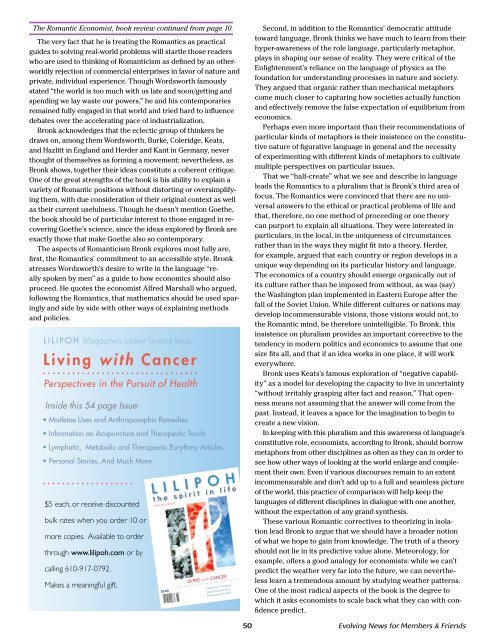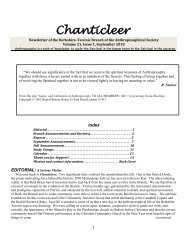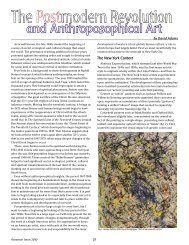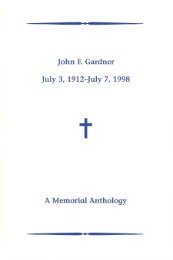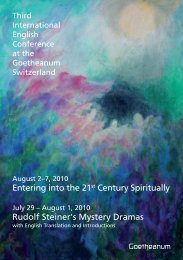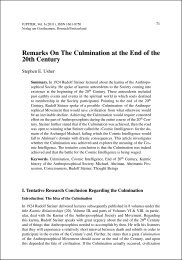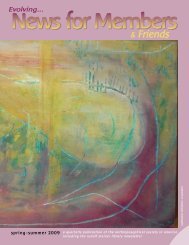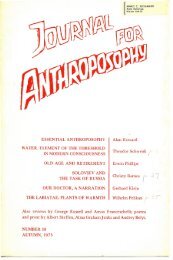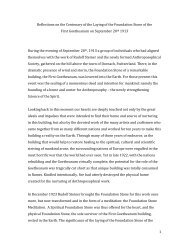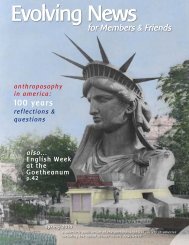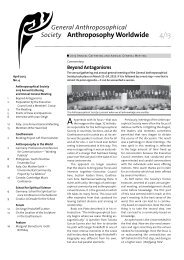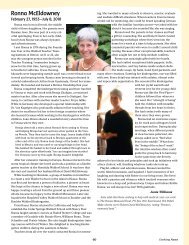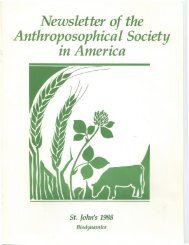& Friends - Anthroposophical Society in America
& Friends - Anthroposophical Society in America
& Friends - Anthroposophical Society in America
Create successful ePaper yourself
Turn your PDF publications into a flip-book with our unique Google optimized e-Paper software.
The Romantic Economist, book review cont<strong>in</strong>ued from page 10.The very fact that he is treat<strong>in</strong>g the Romantics as practicalguides to solv<strong>in</strong>g real-world problems will startle those readerswho are used to th<strong>in</strong>k<strong>in</strong>g of Romanticism as def<strong>in</strong>ed by an otherworldlyrejection of commercial enterprises <strong>in</strong> favor of nature andprivate, <strong>in</strong>dividual experience. Though Wordsworth famouslystated “the world is too much with us late and soon/gett<strong>in</strong>g andspend<strong>in</strong>g we lay waste our powers,” he and his contemporariesrema<strong>in</strong>ed fully engaged <strong>in</strong> that world and tried hard to <strong>in</strong>fluencedebates over the accelerat<strong>in</strong>g pace of <strong>in</strong>dustrialization.Bronk acknowledges that the eclectic group of th<strong>in</strong>kers hedraws on, among them Wordsworth, Burke, Coleridge, Keats,and Hazlitt <strong>in</strong> England and Herder and Kant <strong>in</strong> Germany, neverthought of themselves as form<strong>in</strong>g a movement; nevertheless, asBronk shows, together their ideas constitute a coherent critique.One of the great strengths of the book is his ability to expla<strong>in</strong> avariety of Romantic positions without distort<strong>in</strong>g or oversimplify<strong>in</strong>gthem, with due consideration of their orig<strong>in</strong>al context as wellas their current usefulness. Though he doesn’t mention Goethe,the book should be of particular <strong>in</strong>terest to those engaged <strong>in</strong> recover<strong>in</strong>gGoethe’s science, s<strong>in</strong>ce the ideas explored by Bronk areexactly those that make Goethe also so contemporary.The aspects of Romanticism Bronk explores most fully are,first, the Romantics’ commitment to an accessible style. Bronkstresses Wordsworth’s desire to write <strong>in</strong> the language “reallyspoken by men” as a guide to how economics should alsoproceed. He quotes the economist Alfred Marshall who argued,follow<strong>in</strong>g the Romantics, that mathematics should be used spar<strong>in</strong>glyand side by side with other ways of expla<strong>in</strong><strong>in</strong>g methodsand policies.L I L I P O H Magaz<strong>in</strong>e’s Lastest Special Issue:Liv<strong>in</strong>g with CancerPerspectives <strong>in</strong> the Pursuit of HealthInside this 54 page Issue:• Mistletoe Uses and Anthroposophic Remedies• Information on Acupuncture and Therapeutic Touch• Lymphatic, Metabolic and Therapeutic Eurythmy Articles• Personal Stories, And Much More$5 each, or receive discountedbulk rates when you order 10 ormore copies. Available to orderthrough www.lilipoh.com or bycall<strong>in</strong>g 610-917-0792.Makes a mean<strong>in</strong>gful gift.L I L I p o ht h e s p i r i t i n l i f eSPECIAL EDITION:$5.00LIVING with CANCERp e r s p e c t i v e s i n t h e p u r s u i t o f h e a l t hIntegrative TherapiesNourish<strong>in</strong>g the SoulEmbrac<strong>in</strong>g the SpiritSecond, <strong>in</strong> addition to the Romantics’ democratic attitudetoward language, Bronk th<strong>in</strong>ks we have much to learn from theirhyper-awareness of the role language, particularly metaphor,plays <strong>in</strong> shap<strong>in</strong>g our sense of reality. They were critical of theEnlightenment’s reliance on the language of physics as thefoundation for understand<strong>in</strong>g processes <strong>in</strong> nature and society.They argued that organic rather than mechanical metaphorscome much closer to captur<strong>in</strong>g how societies actually functionand effectively remove the false expectation of equilibrium fromeconomics.Perhaps even more important than their recommendations ofparticular k<strong>in</strong>ds of metaphors is their <strong>in</strong>sistence on the constitutivenature of figurative language <strong>in</strong> general and the necessityof experiment<strong>in</strong>g with different k<strong>in</strong>ds of metaphors to cultivatemultiple perspectives on particular issues.That we “half-create” what we see and describe <strong>in</strong> languageleads the Romantics to a pluralism that is Bronk’s third area offocus. The Romantics were conv<strong>in</strong>ced that there are no universalanswers to the ethical or practical problems of life andthat, therefore, no one method of proceed<strong>in</strong>g or one theorycan purport to expla<strong>in</strong> all situations. They were <strong>in</strong>terested <strong>in</strong>particulars, <strong>in</strong> the local, <strong>in</strong> the uniqueness of circumstancesrather than <strong>in</strong> the ways they might fit <strong>in</strong>to a theory. Herder,for example, argued that each country or region develops <strong>in</strong> aunique way depend<strong>in</strong>g on its particular history and language.The economics of a country should emerge organically out ofits culture rather than be imposed from without, as was (say)the Wash<strong>in</strong>gton plan implemented <strong>in</strong> Eastern Europe after thefall of the Soviet Union. While different cultures or nations maydevelop <strong>in</strong>commensurable visions, those visions would not, tothe Romantic m<strong>in</strong>d, be therefore un<strong>in</strong>telligible. To Bronk, this<strong>in</strong>sistence on pluralism provides an important corrective to thetendency <strong>in</strong> modern politics and economics to assume that onesize fits all, and that if an idea works <strong>in</strong> one place, it will workeverywhere.Bronk uses Keats’s famous exploration of “negative capability”as a model for develop<strong>in</strong>g the capacity to live <strong>in</strong> uncerta<strong>in</strong>ty“without irritably grasp<strong>in</strong>g after fact and reason.” That opennessmeans not assum<strong>in</strong>g that the answer will come from thepast. Instead, it leaves a space for the imag<strong>in</strong>ation to beg<strong>in</strong> tocreate a new vision.In keep<strong>in</strong>g with this pluralism and this awareness of language’sconstitutive role, economists, accord<strong>in</strong>g to Bronk, should borrowmetaphors from other discipl<strong>in</strong>es as often as they can <strong>in</strong> order tosee how other ways of look<strong>in</strong>g at the world enlarge and complementtheir own. Even if various discourses rema<strong>in</strong> to an extent<strong>in</strong>commensurable and don’t add up to a full and seamless pictureof the world, this practice of comparison will help keep thelanguages of different discipl<strong>in</strong>es <strong>in</strong> dialogue with one another,without the expectation of any grand synthesis.These various Romantic correctives to theoriz<strong>in</strong>g <strong>in</strong> isolationlead Bronk to argue that we should have a broader notionof what we hope to ga<strong>in</strong> from knowledge. The truth of a theoryshould not lie <strong>in</strong> its predictive value alone. Meteorology, forexample, offers a good analogy for economists: while we can’tpredict the weather very far <strong>in</strong>to the future, we can neverthelesslearn a tremendous amount by study<strong>in</strong>g weather patterns.One of the most radical aspects of the book is the degree towhich it asks economists to scale back what they can with confidencepredict.50 Evolv<strong>in</strong>g News for Members & <strong>Friends</strong>


